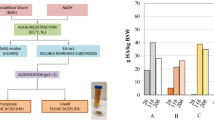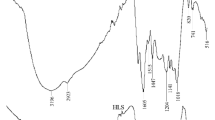Abstract
Factory tea waste is a high lignin and phenolic compounds-containing fibrous material generated in tonnes in tea manufacturing factories. In spite of its high nitrogen content, these physical and chemical properties limit its application as an organic amendment in soil. In this study, a novel technique was developed for extracting humic substrates by recycling factory tea waste and potential of those extracted humic substrates for improving soil properties and tea productivity was evaluated under field condition. Humic substrates are organic soil amendment that is often used for enhancing chemical and biochemical properties in soil. For extracting humic substrates, factory tea waste was processed through multi-step technique combined with easily available plant biomass like aquatic weeds. The method was suitable for extracting up to 25–30 L humic substrate solution containing 25.1 ± 3.8 g L−1 active constituent, 507.3 ± 11.8 mg L−1 total nitrogen and 2.91 ± 0.07 g L−1 total potassium by recycling each kilogram factory tea waste. The extract had shown fair similarity with standard humic acids. Under field condition, extracted humic substrates lead up to 6% increase in tea productivity and improved soil chemical properties. The residue remained at the end of this process was further vermicomposted to prepare organic amendment having total nitrogen content 1.34 ± 0.07 mg g−1 with C/N ratio 10.87 ± 0.92. In this study, the addition of pond sediment produced inferior quality humic substrate and vermicompost.






Similar content being viewed by others
References
Aikpokpodion PE, Ipinmoroti RR, Omotoso SM (2010) Bisorption of nickel(II) from aqueous solution using waste tea (Camella sinencis) materials. Am Eur J Toxicol Sci 2:72–82
Bansal S, Kapoor KK (2000) Vermicomposting of crop residues and cattle dung with Eisenia foetida. Bioresour Technol 73:95–98
Batjes NH (1996) Total carbon and nitrogen in the soils of world. Eur J Soil Sci 47:151–163
Bremner JM, Mulvaney RG (1982) Total nitrogen. In: Page AL, Miller RH, Keeney DR (eds) Methods of soil analysis, part 2, agronomy, vol 9. American Society of Agronomy, Madison, pp 575–624
Burden C, Hancock H, Kurissery S (2015) Study of aerobic and anaerobic bacteria in sediment and their importance in water quality assessment. J Environ Indicat 9:30
Canellas LP, Olivares FL (2014) Physiological responses to humic substances as plant growth promoter. Chem Biol Technol Agric 1:2–11
Chowdhury A, Sarkar S, Chowdhury A, Bardhan S, Mandal P, Chowdhury M (2016) Tea waste management: a case study from West Bengal, India. Ind J Sci Technol 9:1–6
de Lima AA, Alvarenga MAR, Rodrigues L, Chitarra AB (2011) Yield and quality of tomato produced on substrates and with application of humic acids. Hortic Bras 29:269–274
Gomez KA, Gomez AA (1984) Statistical procedures for agricultural research. Wiley, New York, pp 130–139
Goswami L, Pratihar S, Dasgupta S, Bhattacharyya P, Mudoi P, Bora J, Bhattacharya SS, Kim KH (2016) Exploring metal detoxification and accumulation potential during vermicomposting of Tea factory coal ash: sequential extraction and fluorescence probe analysis. Sci Rep. https://doi.org/10.1038/srep30402
Insam H (1996) Microorganisms and humus in soil. In: Piccolo A (ed) Humic substrates in terrestrial ecosystems. Elsevier, Amsterdam. ISBN 0-444-81516-3
Lovely DR, Coates JD, Blunt-Harris EL, Phillips EJP, Woodward JC (1996) Humic substrates as electron acceptors for microbial respiration. Lett Nat 382:445–448
Lu X, Fan J, Yan Y, Wang X (2011) Soil water soluble organic carbon under three alpine grassland types in Northern Tibet, China. Afr J Agric Res 6:2066–2071
Lucas EG, Izquierdo CG, Fernández MTH (2016) Changes in humic fraction characteristics and humus–enzyme complexes formation in semiarid degraded soils restored with fresh and composted urban wastes. A 5-year field experiment. J Soils Sediments. https://doi.org/10.1007/s11368-016-1537-8
Malkoc E, Nuhoglu Y (2005) Investigations of nickel(II) removal from aqueous solutions using tea factory waste. J Hazard Mater 127:120–128
McKnight DM, Behmel P, Francko DA, Gjessing ET, Munster U, Petersen RC Jr, Skulberg OM, Steinber CEW, Tipping E, Visser SA, Werner PW, Wetzel RG (1990) How do organic acids interact with solutes, surfaces, and organisms? In: Perdue EM, Gjessing ET (eds) Organic acids in aquatic ecosystems. Wiley, New York, pp 223–243
Nelson DW, Sommers LE (1982) Total carbon and organic carbon. In: Page AL, Miller RH, Keeney DR (eds) Methods of soil analysis, part 2, agronomy, vol 9. American Society of Agronomy, Madison, pp 539–579
Olsen SR, Sommers LE (1982) Phosphorus. In: Page AL, Miller RH, Keeney DR (eds) Methods of soil analysis, part 2, agronomy, vol 9. American Society of Agronomy, Madison, pp 403–413
Oshita K, Okumura T, Takaoka M, Fujimori T, Appels L, Dewil R (2014) Methane and nitrous oxide emissions following anaerobic digestion of sludge in Japanese sewage treatment facilities. Bioresour Technol 171:175–181
Pramanik P (2010) Changes in enzymatic activities and microbial properties in vermiwash of water hyacinth as affected by pre-composting and fungal inoculation: a comparative study of ergosterol and chitin for estimating fungal biomass. Waste Manag 30:1472–1476
Pramanik P, Kim PJ (2014) Fractionation and characterization of humic acids from an organic amended rice paddy soils. SciTotal Environ 466–467:952–956
Pramanik P, Ghosh GK, Ghosal PK, Banik P (2007) Changes in organic—C, N, P and K and enzyme activities in vermicompost of biodegradable organic wastes under liming and microbial inoculants. Bioresour Technol 98:2485–2494
Pramanik P, Safique S, Jahan A, Bhagat RM (2017) Humic substrates application in diluted form enhanced availability of phosphorus (P) and its uptake by tea bushes in the tea-growing soil of Northeast India. J Plant Nutr 40:2841–2849
Scharer JM, Devlesaver V, Girard P, Moo-Young M (1987) Acid production from insoluble carbohydrates by anaerobic digestion. In: Moo-Young M (ed) Biomass conversion technology: principles and practice. Pergamon Press, Maxwell House, New York, pp 77–82
Serdar G, Demir E, Sokman M (2017) Recycling of tea waste: simple and effective separation of caffeine and catechins by microwave assisted extraction (MAE). Int J Second Metab 4:78–89
Silva JR, Silva DJ, Gava CAT, Oliveira TC, Freitas MSC (2016) Carbon in humic fractions of organic matter in soil treated with organic composts under mango cultivation. Rev Bras Cienc Solo 40:1–11
Solomons TWG, Fryhle CB, Snyder SA (2012) Organic chemistry, 11th edn. Wiley, London. ISBN 978-1-118-13357-6
Suarez-Estrella F, del Carmen Vargas-Garcia M, Lopez MJ, Moreno J (2008) Effect of humic substrates extracted from compost to plant growth and soil microorganisms. In: Hao X (ed) Compost I, dynamic soil, dynamic plant 2 (Special Issue 1), pp 96–102
Tandon KH (2010) Principles of soil chemistry, 4th edn. CRC Press, Taylor and Francis Group, London. ISBN 978-143981-395-9
Tokay F, Bagdat S (2015) Evaluation of humic acid content and zinc levels in soil, olive fruit and leaf samples in Edremit Bay. Int J Chem Sep Technol 1:1–7
Wasewar KL, Atif M, Prasad B, Mishra IM (2009) Batch adsorption of zinc on tea factory waste. Desalination 244:66–71
Acknowledgments
Authors are thankful to the Director, Tocklai Tea Research Institute, Tea Research Association, Jorhat, Assam, for providing necessary facilities to conduct the experiment. The work of this manuscript was part of an In-house Project.
Author information
Authors and Affiliations
Corresponding author
Additional information
Editorial responsibility: Necip Atar.
Electronic supplementary material
Below is the link to the electronic supplementary material.
Rights and permissions
About this article
Cite this article
Pramanik, P., Safique, S. & Jahan, A. Humic substrates extracted by recycling factory tea waste improved soil properties and tea productivity: an innovative approach. Int. J. Environ. Sci. Technol. 16, 3761–3770 (2019). https://doi.org/10.1007/s13762-018-1791-y
Received:
Revised:
Accepted:
Published:
Issue Date:
DOI: https://doi.org/10.1007/s13762-018-1791-y




